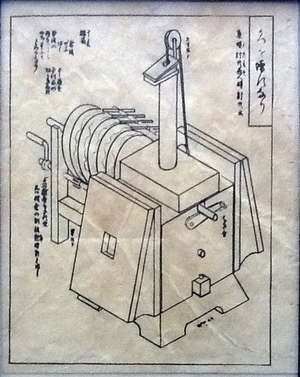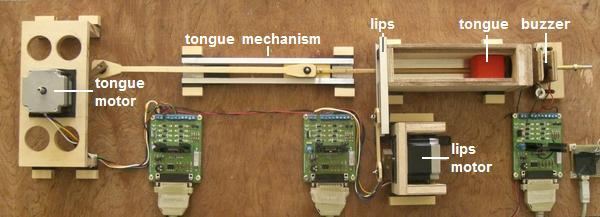

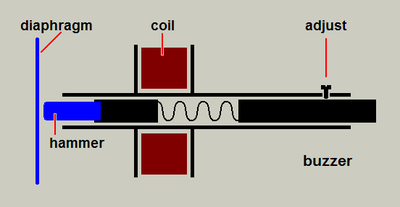
The tongue and lips were driven by stepping motors. Yuichi Matsumoto prepared the hardware and control software and Yu Takahashi taught the machine to sing Finita iam sunt proelia by Palestrina in four-part harmony (three of the voices were pre-recorded). While waiting for the hardware, I added S, T and F whistles, similar to those on my Talking Machine with a hand-operated bellows to supply the air.
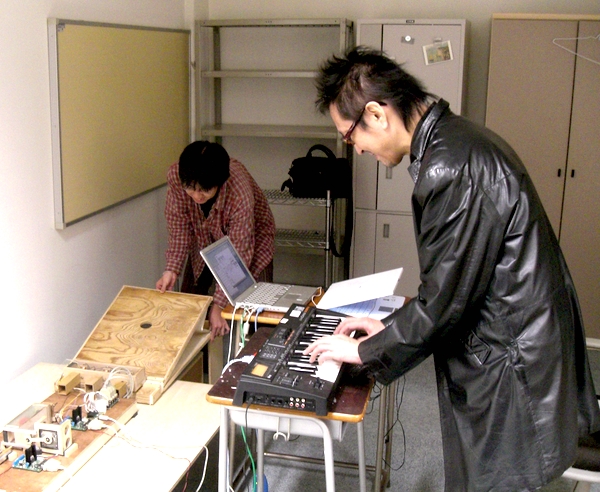
All this was a most promising start. I had a great time in Ogaki with bike rides to places like the Sekigari battle field, the Yoro waterfall and the Sunomata castle. Back in Europe, I started on a second version.
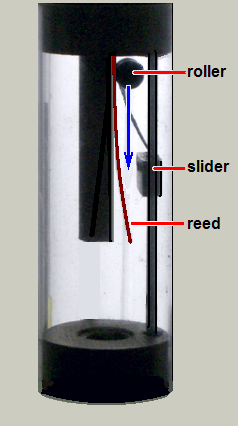
|
Air blown reed with adjustable pitch The effective length of the curved reed (brown) is adjusted by a roller running up and down and pressed against it by a spring. The spring is carried by a slider, driven by a motor. The idea comes from organ-building practice, where a fixed spring (without a roller) is used to fine-tune the pitch of the reed. |
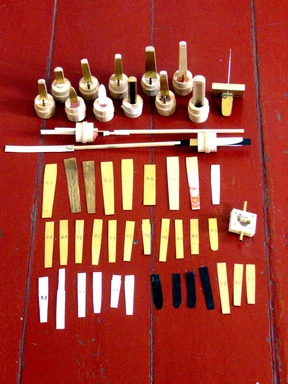
|
Reed experiments The round things at the top are holders for the reeds, in organ parlance, so I learnt, a kelch. The square one, (top right), is from my Talking Machine. It took some experimentation with different kinds of material, shapes and thicknesses to find the right kind of reed. Here are some of my mistakes, most of them made of hammered brass, the traditional material. The current version is a modest strip of polystyrene, 0.5 mm thick. (bottom left.) |
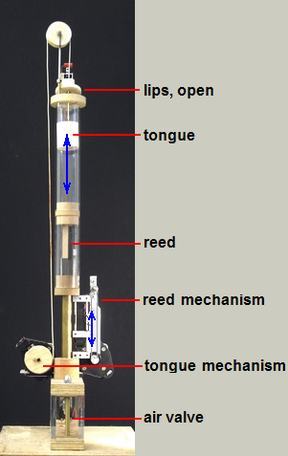
|
The vocal tract The tongue is a cylinder of balsa wood with a 1 cm. hole through the middle. It moves up and down inside the mouth (a Plexiglas tube) to different positions to pronounce the vowels "ee", "eh", "oo", "aw" and "ah". When the tongue is in the "oo" position (about half way up) the lips close to form a narrow extended aperture like our pursed lips when we say "oo". The reed mechanism provides the up-and-down movement for the slider that controls the pitch. The tongue motor turns a balsa wood drum to raise and lower the tongue. The tongue and lips sometime have to move very fast so I made these parts out of balsa wood to reduce their mass. The air valve controls the flow of air from the blower. |
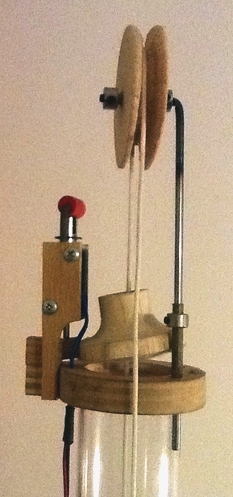
|
A close-up of the lips and mouth. On the left the electro-magnet which closes the narrow lips to pronouce an "oo" sound. The hole through the lips is about 8 mm wide at its narrowest point but still wide enough to allow the chord that moves the tongue to pass freely. |
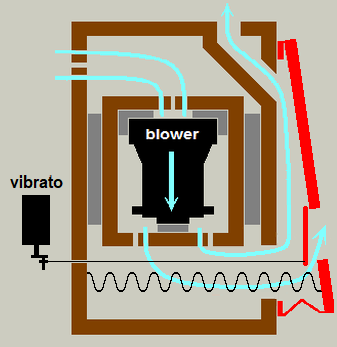
|
The blower A vacuum cleaner blower is cushioned in foam rubber and enclosed within two boxes which act as sound-proofing. The air passes through these boxes through many narrow holes that further reduce the noise. The air pressure is regulated by a bellows (red) that is pulled closed with a spring. When the bellows inflates, a valve opens and spills the superfluous air. The valve can also be regulated by a vibrato motor. The well-ventilated spaces above and below the blower contain a triac circuit that reduces the speed of the motor; the drivers for the stepping motors that control the tongue and the pitch of the reed; and a power supply. |

|
a side view of the vocal tract. Since the air pressure is critical, the machine is fitted with a pressure gauge, an S-shaped tube filled with water coloured with a florescent dye and a scale marked in centimeters. This is very useful when adjusting the speed of the blower and the opening of the valve in the bellows. This derives from organ-building practice where air pressure is traditionally measured in centimeters or inches of water. The Singing Machine runs at 5 cm of water. |
'VOWELS NOTES AIR CLOCK MISC
reset clock,
Oo, C3, 0.2",
reset clock,
on, 1.2",
off,
Eh, D3, on, 1.8",
Ah, F3, 2.4",
off,
D3, on, 3.0",
Ih, E3, 3.6",
D3, 4.4",
off, reset clock,
0.2", home,

To hear a sound recording of the first verse of Ut queant laxis click here
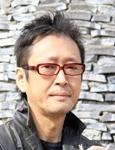
Masahiro Miwa |
hitonokiesari( people vanish ) |
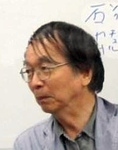 Sadakazu Fujii |
The poem consists of seven stanzas, each of seven lines with seven syllables.
A further rule: syllables are not repeated in the same line.
It provides the vowels, diphthongs and pitches for the Singing Machine.
|
The morning of the evil god thus destroyed the beginning of the event the example of arrogance into the fire crows tumble chickens squawk |
ma Ga tsu Bi no a sa
ko u shi te ho ro bu
ko to no ha Ji ma ri
o Go ri no ta me shi
hi ni mo e sa ka ri
no ta u tsu ka ra su
sa ke Bu ni ua to ri
|
|
Slugs crawl creeping over the cooling cold tsuchinoko 2 must turn receive and drink the slimy water all living things |
na me ku ji ra ha e
na me te ha i Zu ri
hi ia se tsu me ta ku
ma ua re tsu chi no ko
he Do ro no mi Zu o
u ke te no mi ho se
i ki mo no su Be te
|
|
Disappearance of the land division of the sea hitonokiesari 1 sudden song coffins sleep fire beckons spirits mumble |
ri ku no sho u me tsu
u mi no sa ku re tsu
hi to no ki e sa ri
hi ra me ku u ta no
hi tsu Gi ua ne mu ru
mu ka e Bi ta ra shi
tsu Bu ia ku mo no ra
|
|
Illusion blows whirlwind of fire 3 morning tornado a voice rises the word ofAshura 4 Monju-Bodhisattva 5 speaks Sutra 6 lamentation |
ma Bo ro shi ni hu ku
hi no ka ma i ta chi
a sa no ta tsu ma ki
ko e ta chi no Bo ri
a shu ra no ko to Ba
mo n Ju ua ka ta ru
ka na shi mi Do kio u
|
|
The posy of purple flowers 7 fall in water and open the way to dreams pluck the flowers hold the fire grasp the core young gods |
mi Zu ni chi ri Bo u
mu ra sa ki no ta Ba
iu me ji ni hi ra ku
su e tsu mu ha na ka
Da ki shi me io hi no
ro shi n te Zu ka mi
o sa na Ga mi ta chi
|
|
A white wave far away seen from the shore life is a treasure a jade pillow 8 the deepness of sleep the smile of the gods spirits awaken |
shi ra na mi to o ku
ki shi be ni mi e te
i no chi Zo ta ka ra
hi su i no ma ku ra
ne mu ru hu ka sa o
ka mi no Bi sho u De
mo no ra o ki Da su
|
|
Children play on their slide of fire the burning tribe still smoulders cold fire pray by the window like a phoenix |
a so Bu ko Do mo no
hi no su be ri Da i
mo e ru ka Zo ku no
na o mo ku su Bu ru
tsu me ta ki ho no o
i no ru ma do Go shi
hu shi cho u no Go to
|
My Singing Machine sings in Giyakku.
Giyakku is the legendary singing language of the legendary Giyakku people. It is a dialect of Japanese. Briefly, it consists of the vowels: eh ee oo ah oh. These 5 vowels and a variety of diphthongs are sung at 13 different pitches, from C2 to C3, providing a total of 109 Japanese syllables. Capital letters are sung with an upward glissando.
For example, the Japanese title, hitonokiesari, (hi-to-no-ki-e-sa-ri) is sung in Giyakku as
hi ee E
to oh B
no oh C#
ki ee D#
e eh D#
sa ah F
ri ee A#
The Singing Machine singing the word hitonokiesari: recording
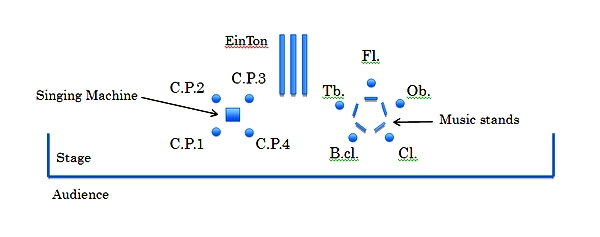
On the left, the Singing Machine with four percussionists playing "consonant pipes". In the centre, my sound installation Ein Ton, (three pipes tuned to almost the same pitch, providing a throbbing drone.) On the right: flute, oboe, clarinette, bass clarinet and trombone..
The Giyakku disappeared during the surpression of the short-lived Republic of Ezo (1869). The only survivor is said to have been a young man who was apprenticed to a master carpenter in Tokyo and built a hand-operated singing machine to preserve the memory of his race and culture. This fabled machine survives only as a drawing.
